
Searching for reptiles and amphibians – affectionately termed “herping” – is an interesting pastime that often gets the enthusiast deep into fascinating habitat in far-away places – just like birding! Unlike birds, however, the vast majority of herps do not make themselves noticeable in any way – they neither sing loudly (except frogs!) nor do they move in a conspicuous manner – so finding many of them requires a lot of effort, often including long nights and a lot of physical lifting of rocks and other materials.
Canada does not immediately appear as a country that would offer good “herping” opportunities. Most of it is locked in a brutal winter for five or more months out of the year. Unable to migrate, reptiles and amphibians have to adapt to living through this admittedly large hurdle, and not many species can. Compared to the USA, which is home to approx. 545 species of reptiles and amphibians, Canada has 48! That being said, the species that reside in Canada are charismatic, many of them are easy to observe, and all have different and amazing methods of surviving the challenges that this harsh landscape brings. It is one of my favourite countries for herping, and I find it quite rewarding.
Believe it or not, herps can be found in Canada at every time of year. As a young naturalist, a wintertime rite here in Ontario was searching for the bizarre Mudpuppy, an aquatic salamander that is active all year-round, hunting for small fish and invertebrates underneath the ice. Finding mudpuppies in winter requires one to find an area of open water – a dam does nicely – and spotlighting the bottom for movement. This particular night, we found 56 individuals! Also note the layer of snow beneath the holding tank!
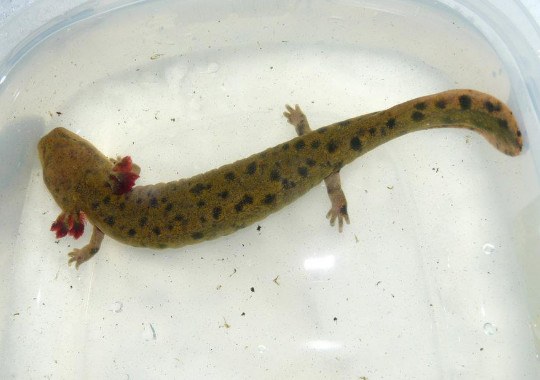
However, the Mudpuppy is an exception to the rule and herping really begins in earnest in April and May, when another group of salamanders emerges to breed. These are the Ambystoma, or Mole Salamanders, named for the fact that many species spend most of their lives deep underground. During early spring however, hundreds of individuals will migrate from their subterranean haunts to vernal pools (those that dry out in summer) to breed. This is a night-time adventure that often occurs when there is still snow on the ground. The salamanders gather in large groups, where males try to entice females to pick up their sperm packets (called spermatomores) and fertilize their eggs. This flurry of activity lasts for only a couple of weeks, before the salamanders return underground, the adults not to be seen again until the following year.
The most common of these salamanders in Ontario is the attractive Spotted Salamander. They are often found alongside Blue-spotted Salamanders, as was the case with this breeding pool in Algonquin Park, Ontario.
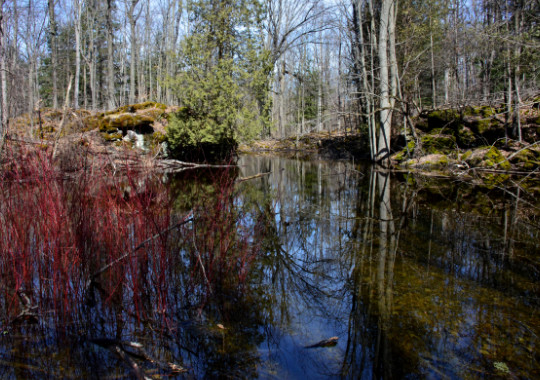
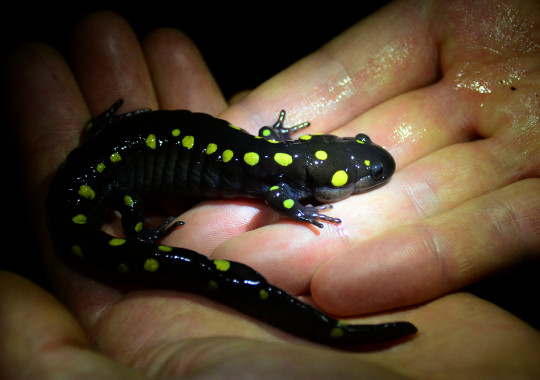
Shortly after the salamanders emerge, the woods of Canada are filled with the songs of recently-emerged frogs. The first of these is the Wood Frog, which has the amazing ability to freeze solid in the winter, producing extremely high levels of glucose near winter which prevent ice from forming inside of its cells, and prevent them from dehydrating by keeping moisture inside. They are the first of many species to lend their voices to the spring chorus, and also the most northerly amphibian in North America, ranging all the way into Alaska and throughout northern Canada. Other frogs soon join in – Spring Peepers, Western & Boreal Chorus Frogs, Northern Leopard Frogs, and Grey Treefrogs in Ontario. Toads being breeding slightly later, with a handful of species found in Canada.

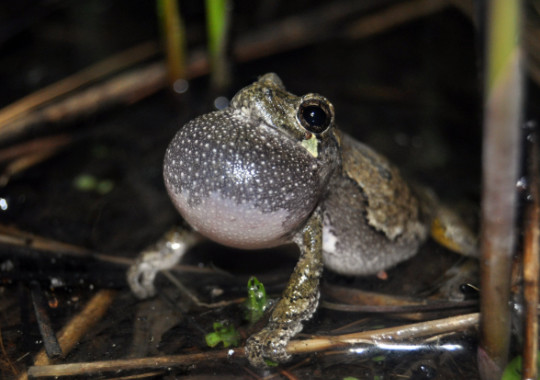
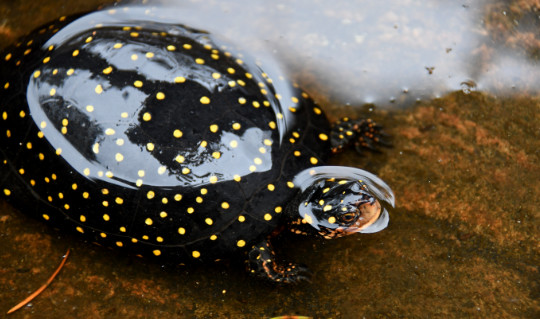
Turtles, having spent the winter buried under the mud or on the rocky bottoms of wetlands, are a common sight, basking on logs and rocks. Canada has several species of turtles, especially in the east, and I am lucky to live in the “turtle capital of Canada”, which is Ontario – home to 8 native species.
The Spotted Turtle is perhaps one of the most attractive. This small turtle, rarely reaching 13 cm in length, can be common in certain areas – but its small size, difficult-to-access habitat, and popularity as a household pet has made it one of the most difficult turtles to find. Nonetheless, in early spring, if one is very lucky, they may encounter this amazing little turtle.
Wood Turtles are the rarest turtles in Ontario, but they are more common in the eastern provinces such as New Brunswick. Every sighting of a Wood Turtle is special, as their populations across their now-fragmented range across the eastern USA and Canada have taken a hard toll from roads, habitat destruction, and illegal collection for the pet trade – something that many turtles face all over the world. This turtle spends much of its time away from water in the summer, and resembles a tortoise more than conventional pond turtles. It is slow and deliberate, walking on powerful legs through the woodlands in search of berries and earthworms. Being in the company of one is a humbling experience.
The Blanding’s Turtle is yet another endangered turtle that occurs in Ontario, but thankfully it is more widespread and seems less targeted by the pet trade as the previous two. It is an impressive beast, sporting a long, yellow neck – and an expression that suggests it is always smiling!
The most common turtles in Canada are the Snapping and Painted Turtles. There are three subspecies of Painted Turtles in Canada, though they look quite similar to one another. These turtles are the most likely species that a casual observer will encounter while paddling or going for a hike. They are widespread and use a variety of wetland habitats.
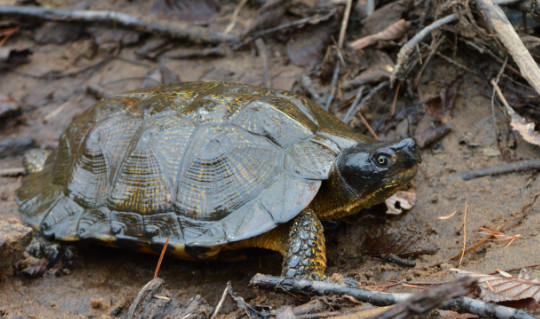
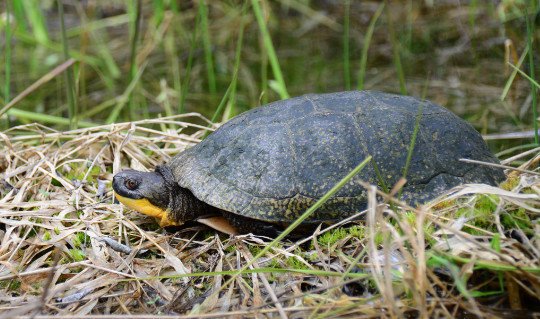
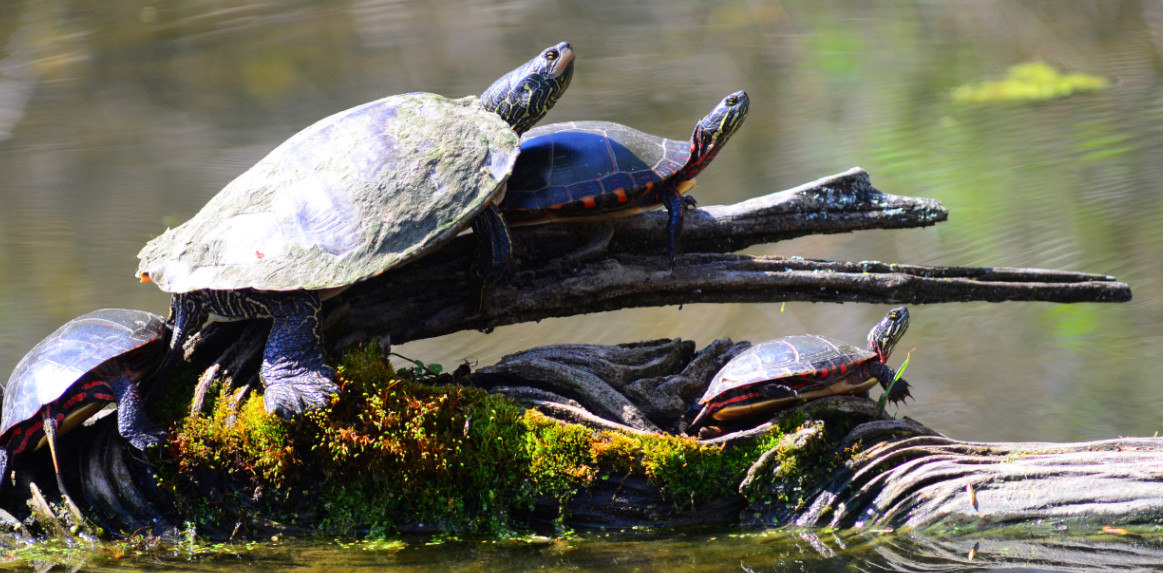
Two oddball turtles exist in Canada that may be of a surprise to the observer. One is the Spiny Softshell, a pancake-shaped turtle that lives in sandy-bottomed lakes and rivers in southern Ontario that is more reminiscent of a sea turtle than its freshwater neighbours. It is built for swimming, and a sighting of a spooked softshell blasting through the water will shatter any stereotypes of slow turtles. This species requires large water bodies to survive. Their range may be a linear 30 km and they have been known to travel over 4 km per day!
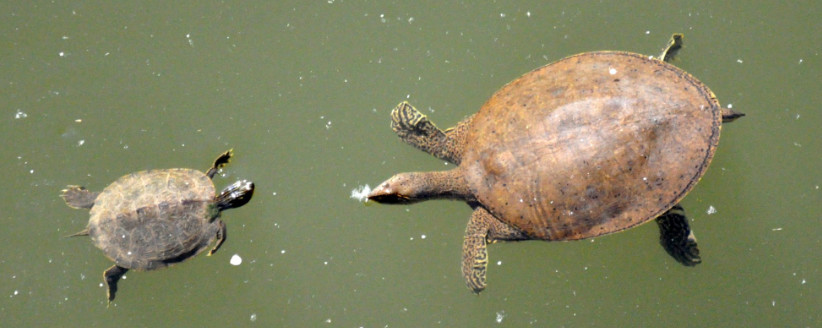
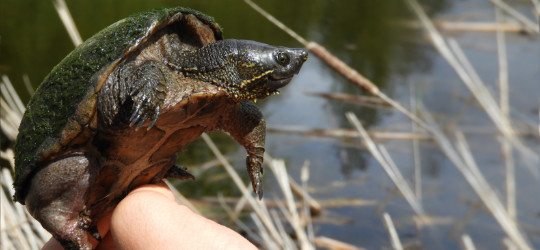
The Eastern Musk Turtle is the only species of this rather large family of turtles in Canada. There are a few recent observations from Québec, but it can be abundant in southern Ontario – though even Ontarians may be unfamiliar with this English name, as the local name used by scientists and citizens alike in Ontario is “Stinkpot”. The Stinkpot bares both of these English names because, when distraught, it releases a foul-smelling musk, much like a Snapping Turtle. These turtles are almost entirely aquatic, only coming ashore to lay their eggs, and almost never basking in the open like other turtles. They are also very small, and a close inspection will reveal a variety of tubercles extending from all over the body, providing an excellent form of camouflage. Indeed, when one seeks Stinkpots, the best way to find them is to don a mask and snorkel and join them in their underwater world!
The biggest draw for many herping enthusiasts is snakes. And who could blame them? Snakes are fascinating and beautiful, and finding many species means going out into wild terrain, using clues such as weather and habitat to predict where you would find them, and using all of this together in the field until you encounter your quarry. It is very similar to birding, but I find it even more challenging, which is why I am a big fan of snakes.
Which is a good thing, as I live in one of the most diverse areas in Canada for snakes, Ontario playing host to 18 of the 35 recognized species and subspecies found in Canada. One of the most common questions I received from guests while working in the parks system was, “Are there any venomous snakes in Canada?” They would always be surprised when the answer was “Yes, there are!”
While it has recently been discovered that gartersnakes and watersnakes produce a weak venom, Canada has three species of rattlesnakes that can deliver a painful and potentially fatal bite – though, death by snakebite is extremely rare in Canada. The species that people encounter most often lives in a very popular cottaging area for many residents of southern Ontario – Georgian Bay.
See Lev’s upcoming tours here
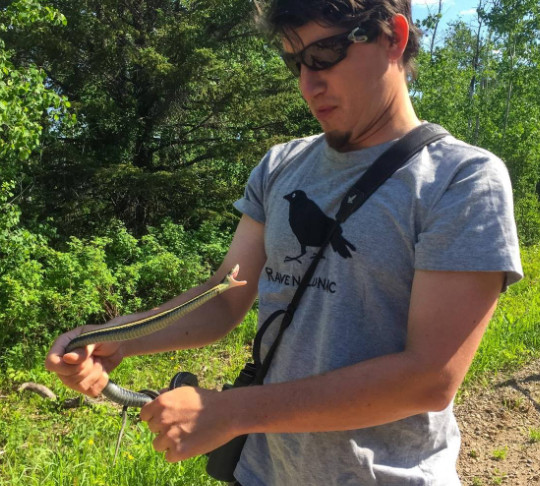
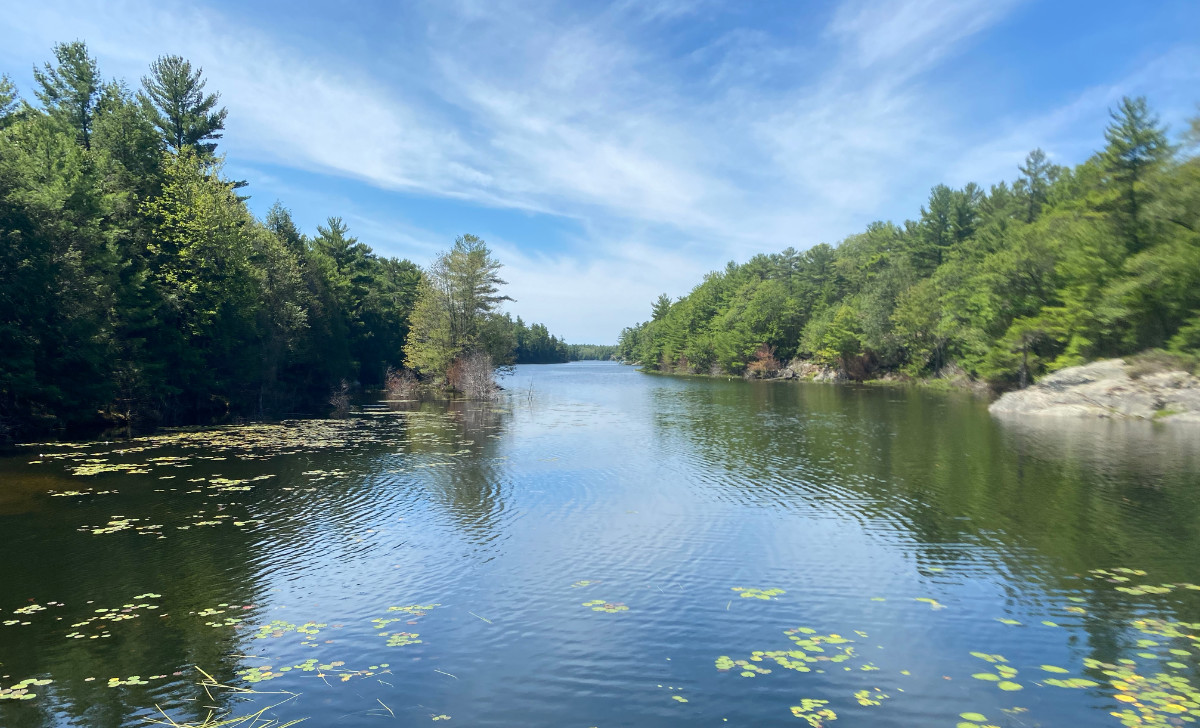
It is the Eastern Massasauga, a very small and placid rattlesnake. Fortunately for both snake and human, they are very timid and are quick to move out of the way – even when nearly stepped on. Only two deaths have ever been reported from Massasauga bites in Ontario.
The other two species are the North Pacific and Prairie Rattlesnakes. These have more powerful venom than the little Massasauga. Prairie Rattlesnakes are found in southern Saskatchewan and Alberta, and North Pacific Rattlesnakes occur in British Columbia, especially in the Okanagan Valley. All rattlesnakes in Canada enjoy special protection in addition to the protection they automatically receive when in protected areas, yet many are needlessly killed by uninformed people each year.
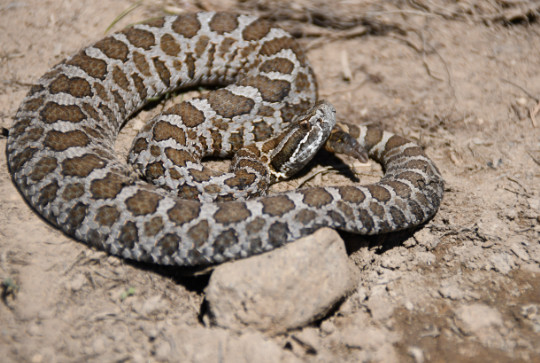
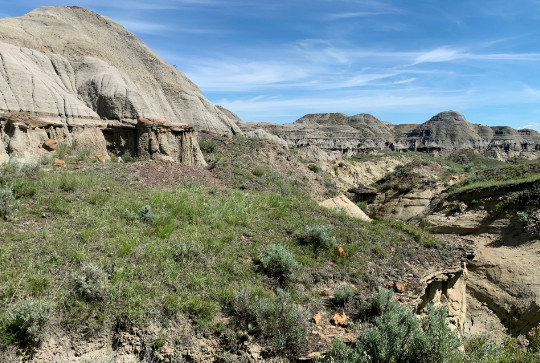
The Okanagan is a unique habitat in Canada – a hot, dry, sagebrush-filled valley that supports a variety of birds and other animals found nowhere else in the country. It is a particularly good place for reptiles. One of the most bizarre Canadian reptiles calls the valley home – the Northern Rubber Boa. It is in the same family as the Boa constrictor and the anacondas, but is much, much smaller! Unlike most Canadian snakes, which seek out open, dry areas where they can bask, Rubber Boas prefer shaded old forest. This makes them very difficult to find, but I got lucky this summer in the Okanagan and managed to find this small male – an incredible snake!
Probably Canada’s most visually-striking snake is the Smooth Greensnake, found in Ontario, Manitoba and Québec. This snake is very small and little-known, living in grassy fields and the edges of wetlands and feeding primarily on insects. When encountered, it often begins to move very slowly and deliberately, shaking like a blade of grass to aid in camouflage. It is one of the most northerly snakes to lay eggs in Canada. Many species give birth to live young, having the eggs developing inside the body, which makes it easier for them to get to the correct temperature for hatching.
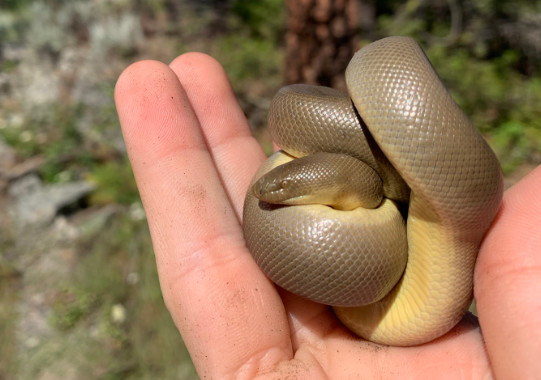
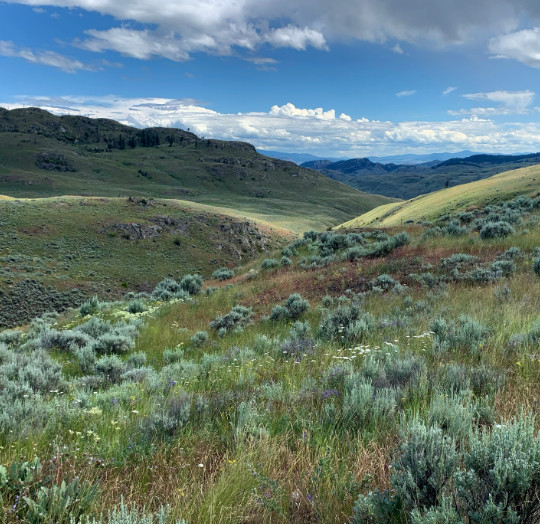
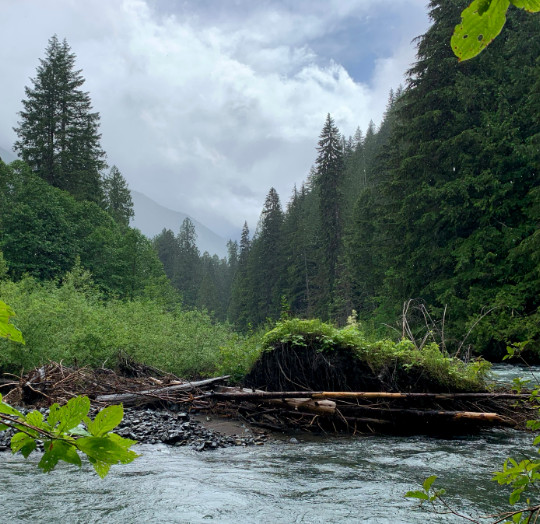
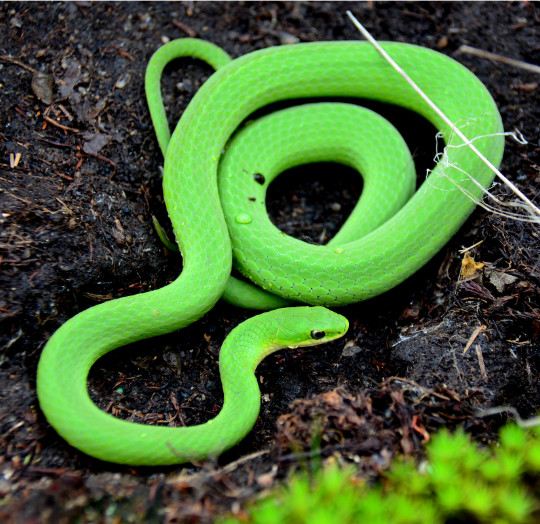
Well-known for putting on a show, two species of hog-nosed snakes occur in Canada – the Western Hognose in central Canada, and the Eastern Hognose in Ontario. These rear-fanged snakes feed mostly on toads, and live in very sandy areas. They are large and impressive, and when encountered will often hiss loudly and flare a cobra-like hood. But this is only the first act – if the intruder decides to continue the attack, the hognose snake will defecate and musk all over itself, flip over on its back, convulse and open its mouth – feigning death. If flipped over, it will promptly turn onto its back again! It is a surprisingly complex and fascinating behaviour for a snake. Unfortunately, hognose snakes are large and slow-moving, vulnerable to road mortality – and their penchant for being loud when encountered often gets them mistaken for rattlesnakes and killed.
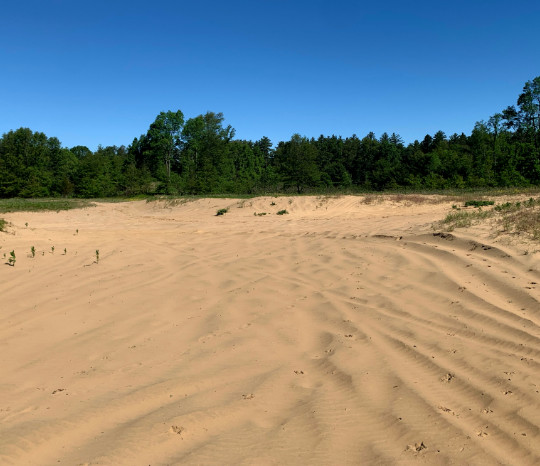
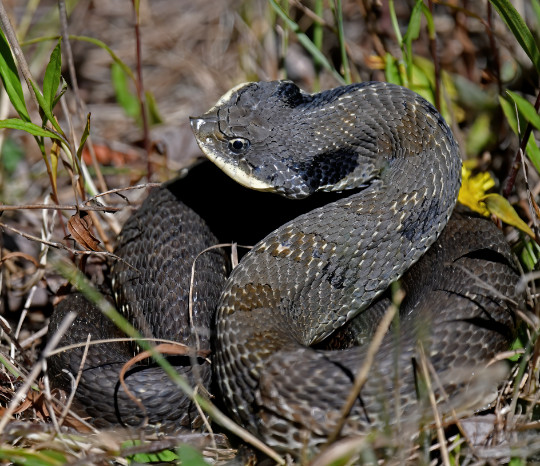
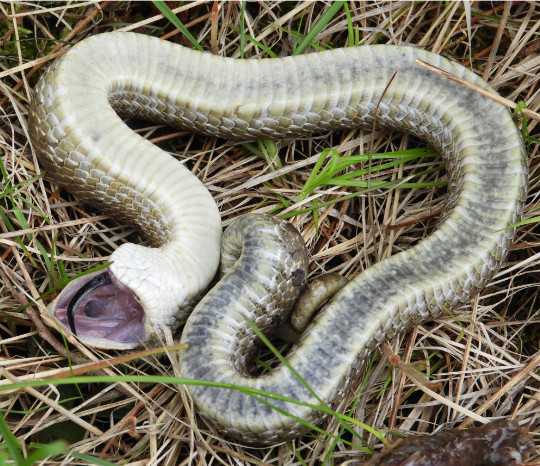
The largest snakes that occur in Canada are ratsnakes. The Grey Ratsnake, the Bullsnake, and the Eastern Foxsnake are often mistaken for rattlers, as they often rattle their (rattleless) tail in their defensive postures. Unlike rattlesnakes, when cornered, many individuals are not afraid to bite! These qualities, unfortunately, often get these snakes needlessly killed. They are very important control agents for rodents and are an important part of the ecosystems they inhabit. The largest of them all is the Grey Ratsnake of Ontario, which sometimes reaches over 2.5 metres, or eight feet!
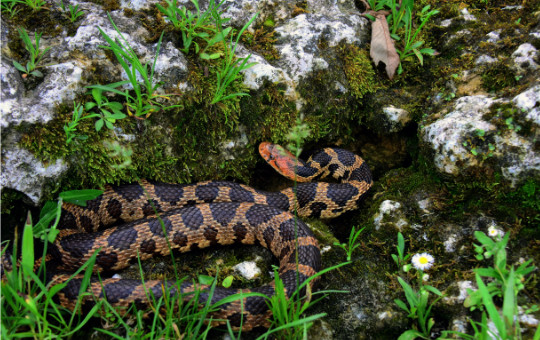
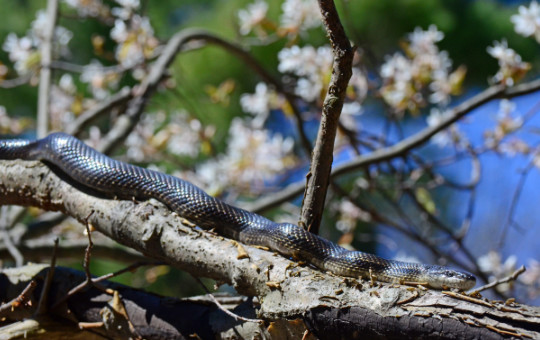
The casual observer isn’t likely to encounter any of these fancy snakes when not specifically looking for them, but gartersnakes of one species or another are often a trailside feature in many parts of Canada. They’re harmless and quick to get out of the way when approached – though many “herpers” will tell you that some individuals are rather bitey in the hand! They are the northernmost snakes on the continent and are often the only snakes in their range. There are several species and subspecies, though I find that the Eastern Gartersnakes found in northern Ontario, which are often bright red, the most striking.
Perhaps one of the greatest herpetological spectacles in the entire world, in the small town of Narcisse, Manitoba, 70’000 Red-sided Gartersnakes emerge from their communal winter quarters in May and again return in September. In some popular areas, the ground is literally covered with writhing gartersnakes, warming up and mating. It is quite an amazing sight!
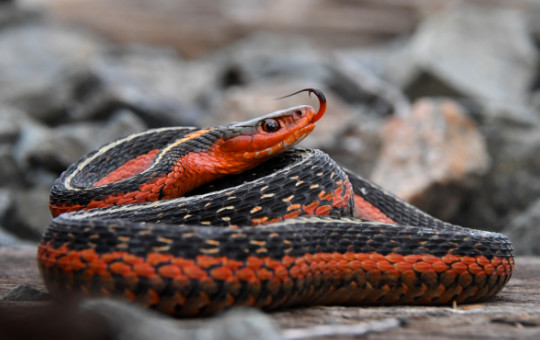
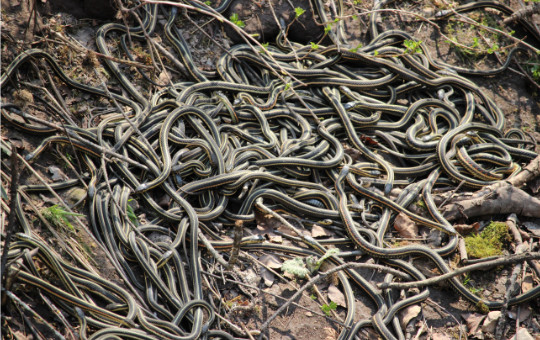
Snakes and Turtles are the most commonly-seen “herps” in Canada. Lizards are not well represented – only five native species occur. Three are skinks that live in small populations in the southern portions of the country, such as the Five-lined Skink of Ontario. The other two are oddballs.
The Northwestern Alligator Lizard, unlike most lizards, prefers to live in humid forests with canopy cover. It resides in British Columbia – in habitat similar to the Rubber Boa mentioned above. They do look like their namesake, with a rather personable looking face with a pale eye, and give birth to live young. They look like a hand-crafted child’s toy.
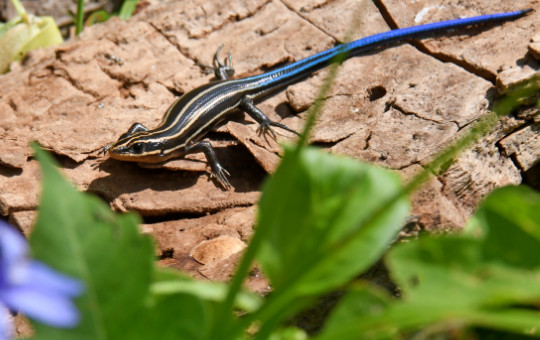
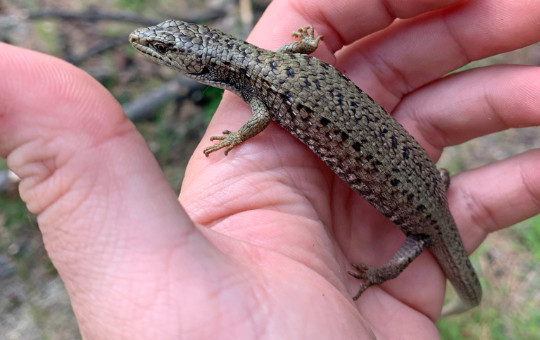
The other Canadian lizard – my personal favourite – looks like it belongs in the mesquite deserts of Texas or Arizona rather than the unforgiving prairie of southern Saskatchewan and Alberta, but there it is – the Greater Short-horned Lizard. Horned lizards are often erroneously given the name “horny toads”, for resembling their amphibian brethren. Its presence in Canada is remarkable, for the same species ranges all the way into northern Mexico. Here it is at the very limit of its endurance, surviving only on a few short months of sufficient heat and sunlight before having to hibernate below the frost line for the remainder of the year. Somehow, they are able to do it. Feeding mostly on ants and giving birth to live young, as well as the ability to project streams of blood out of their eyes towards potential predators make this little lizard one of Canada’s most fascinating creatures.
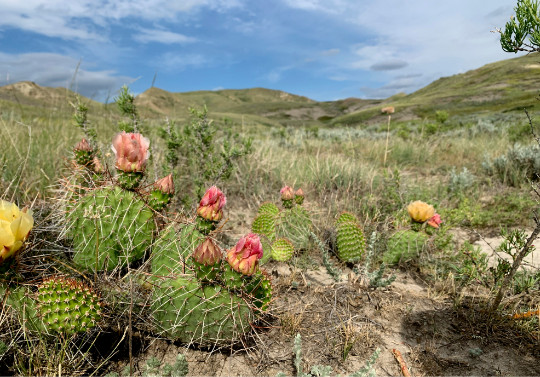
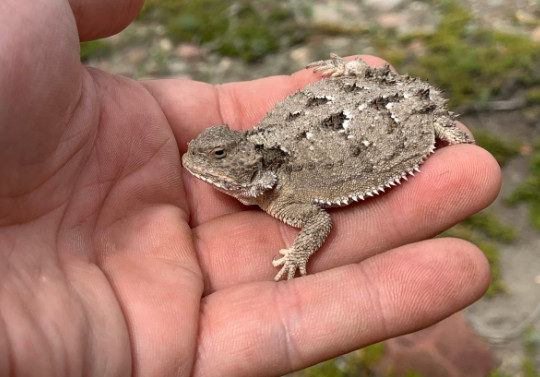
All of these species, for being so different and so well-adapted to each of their specific habitats, faces one large challenge – winter. Turtles and most frogs find their way to the bottom of wetlands – some, well-oxygenated lakes and rivers, and some the mud at the bottom of ponds, to hibernate. There they will go into torpor and be able to extract oxygen from the water through their skin. Some frogs like the Wood Frog freeze solid. Lizards and snakes gather in hibernacula – sites where they can get below the frostline – in rock piles or fissures. Some species, like the Prairie Rattlesnake, share hibernacula with other snake species. Others, like the Massasauga, hibernate singly in crayfish burrows. By the end of October, most reptile and amphibian species have settled down until they once again re-emerge in the spring.
Hopefully this blog has inspired you to have a look for some of the lesser-known creatures in your area as we continue with the quarantine. For me, herping has been one good stress-reducing way to get some exercise and see some cool animals near my home. Spring and autumn are the best times to look for reptiles and amphibians in any part of the temperate world, when the animals are on the move. Summers, if not too hot, can be good for seeing snakes and turtles. Rainy seasons in tropical locations often spur movements as well. An important disclaimer – though you may have seen photos above of herps being handled, remember to never handle an animal whose identify you’re not sure of. Some snakes can deliver deadly bites. Also, the law regarding the handling of reptiles and amphibians varies throughout the world and various governing bodies. Many of the animals in the photos above were handled as part of research with a herpetologist. Most reptiles and amphibians are easily enjoyed with a camera and binoculars and don’t require handling. So, get out there and enjoy the wet and scaly!
Photos by Lev Frid (Except for Narcisse from Wikimedia Commons)
